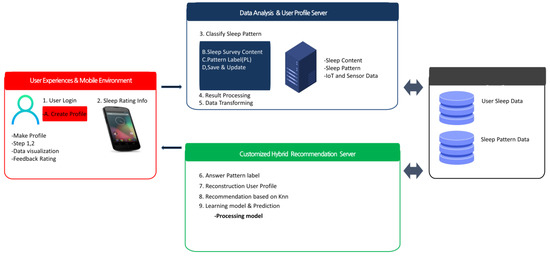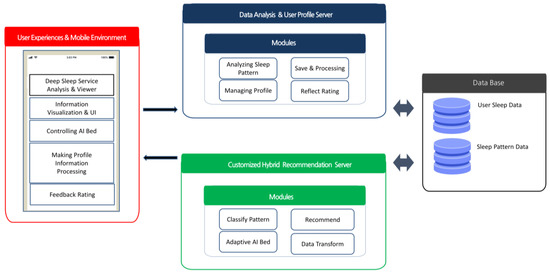You're using an outdated browser. Please upgrade to a modern browser for the best experience.
Please note this is a comparison between Version 1 by Park JiHyeok and Version 2 by Catherine Yang.
Sleep is one of the most important factors for human life in modern society. Optimal sleep contributes to increasing work efficiency and controlling overall well-being. Therefore, a sleep recommendation service is considered a necessary service for modern individuals.
- recommender system
- deep learning
- sleep technology
1. Introduction
Sleep is considered to be one of the most significant factors in modern society that affects human life [1]. As we can see from events like “World Sleep Day,” the importance of sleep is emphasized in our daily lives, and efforts are being made worldwide to prevent and manage sleep disorders. Sleep technology, or “sleep tech,” is recognized as a future industry and is gaining traction, as demonstrated by its inclusion in CES 2020~2022, and it is evolving into various fields through the integration of artificial intelligence and IoT technologies [2][3][4][2,3,4].
Sleep technology, also known as “sleep tech”, is a combination of sleep and technology that aims to improve the quality of sleep by analyzing sleep-related data. The initial steps in this field involved the integration and development of IoT technology [5]. One of the representative products is the motion bed, which collects sleep data from the user and analyzes them to improve the user’s sleep environment [6][7][6,7]. Other research directions in sleep technology involve data analysis such as brainwave analysis. Standardized evaluation guidelines are being designed using biological data collected from existing IoT devices, and service satisfaction is being improved through user satisfaction surveys [8]. However, because sleep evaluation guidelines vary between studies and there is no international standard for optimal sleep, it cannot be deemed sufficient to provide accurate sleep state predictions and personalized services. In order to provide personalized sleep services, a requirement for personalized sleep pattern analysis is present [9].
2. Deep Sleep Recommender System
2.1. Recommender Systems
Recommender systems (RSs) provide necessary and accurate information to help users choose the most suitable option in a particular environment. This has made RSs popular software [10]. They are successfully used by platform-oriented companies such as Netflix and YouTube to provide recommendations to users [11][12][11,12]. The goal of an RS is to provide personalized content to users, which can reduce their selection time and increase efficiency. Additionally, when used by many users, RSs can help identify situational needs. There are various types of recommendation algorithms, such as collaborative filtering, content-based filtering, and user-based filtering. However, these types of filtering have a major drawback [13]. When a new user starts using the system, the cold start problem occurs. Many studies have been conducted to address the cold start problem [14][15][14,15]. The fields that most use recommendation systems include clothing, movies, and food, among others, and recommendations are provided based on the user’s psychology, personality, and situational information. To provide recommendations, it is important to understand the correlations between this information or apply it according to the RS algorithm. RSs can also provide personalized medicine and digital healthcare in the sleep tech field, helping users improve their health, and can increase the level of predicting and evaluating content by utilizing sleep data [16][17][16,17].2.2. Deep Learning (DL)
Deep learning is one of the methods for implementing artificial intelligence, analyzing data, and deriving results based on algorithms. This is why deep learning is popular in building personalized systems [18][19][20][18,19,20]. Deep learning is used in various fields, and machine learning is divided into three types of learning methods: supervised learning, unsupervised learning, and reinforcement learning [21]. Among them, deep learning is a machine learning method that uses neural networks. Current research shows that machine learning techniques and filtering techniques are used in recommendation systems. Hybrid methods that can use deep learning to improve recommendations are also available [22][23][22,23].2.3. Sleep Technology
Sleep is an essential element of human life, but it can be overlooked in modern times, leading to sleep disorders. For this reason, sleep tech is gaining popularity, and a significant amount of research is being conducted [24][25][26][24,25,26]. Recent techniques in sleep include sleep posture recognition using microwave Doppler radar and machine learning classifiers and sleep posture recognition using dual-frequency microwave Doppler radar [27][28][29][30][31][32][27,28,29,30,31,32]. However, since there is no standard for sleep data, it is difficult for recommendation systems to provide accurate content. As sleep patterns define machine learning and recommendation system performance, further research is needed. In this paper, the main goal is to create a standard using pattern analysis based on cluster characteristics to improve system efficiency using machine learning.2.4. Personalized Systems
The fourth industrial revolution has led to innovative technological advancements such as cloud computing and artificial intelligence, but it has also given rise to the important element of personalized systems [33]. One of the most prominent examples is personalized recommendation systems. These systems provide tailored recommendation services based on a user’s information. When users are satisfied, the quality of the service improves, leading to expansion into various fields.3. The Proposed CDSRS (Customized Deep Sleep Recommender System)
The Customized Deep Sleep Recommender System (CDSRS) process is carried out according to steps 1 to 6 shown in Figure 1. In step 1, it collects sleep information using a customized AI motion bed and transmits the data necessary to create a personal profile. In step 2, the data server in the data store is used to configure the user’s profile and sleep content, and step 3 reconstructs the user’s profile when evaluation information is sent. The hybrid learning method in data processing learns algorithms based on user profiles and user evaluations. In step 4, user feedback provides user profiles and collects user evaluation information, which is then transmitted to the data server. The feedback function helps improve the accuracy of sleep recommendations for users. In step 6, it provides sleep services using motion beds to users through recommendations.
Figure 1.
Customized Deep Sleep Recommender System (CDSRS).

Figure 2.
CDSRS service model and service flow steps.

Figure 3.
System architecture of the CDSRS.
